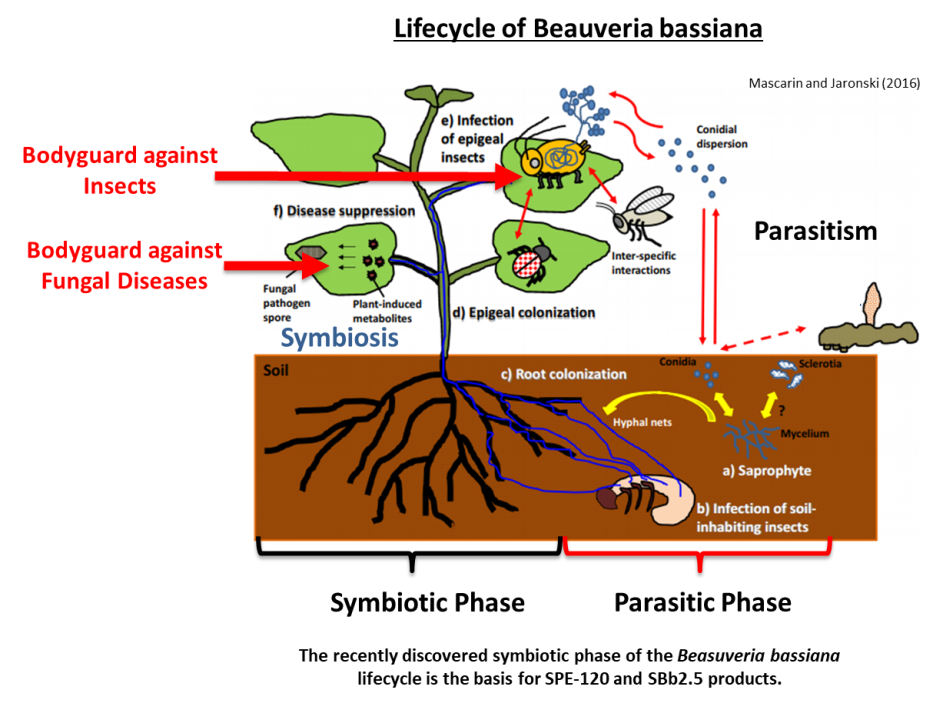
Beauveria bassiana: a Bodyguard for Plants
The fungus Beauveria bassiana was the World’s first Biological Control Agent (“Biological”). The fungus was discovered by the Italian entomologist, Agostino Bassi (1773 – 1856) who discovered that the fungus causes White Muscardine Disease in insects. Bassi’s work, showing that diseases are caused by microorganisms, preceded that of Louis Pasteur, who had a portrait of Bassi in his office. Bassi announced his discoveries in 1835 and Beauveria bassiana came to be used as a very effective and safe Biological for the eradication of insects. But this is only part of why Beauveria bassiana is such a valuable tool for farmers and growers across the world.
The reason why Beauveria bassiana is such a useful fungus is that the direct effect on insects only relies on one part of the lifecycle of the fungus – the parasitic phase. Recently, it has become clear that the fungus also has a symbiotic phase where it lives systemically within a host plant. This endophytic phase brings benefits to both the plant and the fungus. The fungus receives carbohydrates from photosynthesis and the plant receives many positive effects, such as increased resistance to diseases and insects. It is this increased resistance that has led to Beauveria bassiana being called a “Bodyguard for the host plant.”
So how does this work? Well, let us first consider the increased resistance to diseases, especially fungal diseases. Beauveria confers disease resistance broadly by inducing Induced Systemic Resistance (ISR) whereby the plant turns its defenses on to a low level ahead of any attack by disease causing agents. This priming of the plant’s defenses can be effective and can be the difference between the plant or the disease winning. But there is more – Beauveria specifically targets potentially pathogenic fungi and employs several different mechanisms against them.
Taken from Latz et al., (2016)
The first mechanism is mycoparasitism, where Beauveria attacks and parasitizes invading parasitic fungi, resulting in less disease. The second mechanism is antibiosis. Beauveria is known to secrete both antimicrobial proteins and antimicrobials metabolites, both of which can be effective in preventing growth of an invading pathogenic fungus. Finally, there is simple competition. Put simply, if Beauveria bassiana is present throughout the host plant, there is no space left for an invading fungus. This systemic growth of Beauveria is crucial for any successful competition with pathogenic fungi and it is something that sets Beauveria bassiana apart from other Biologicals, such as mycorrhizae and Trichoderma, that primarily interact with the roots.
The next part of the Bodyguard function concerns insects. This increased resistance to insects as a Bodyguard living in the plant is different from the killing of insects by direct spraying that relies on the parasitic phase of the lifecycle. The protection from insects is a more subtle interaction with the insects failing to thrive on plants that contain Beauveria as a Bodyguard. Insects also appear to be able to perceive the Beauveria and actively avoid plants that contain the fungus. In an elegant paper, Pelizza et al. (2017) showed how this works. Corn plants were infected with Beauveria basiana and grasshoppers were then monitored for feeding and reproduction on the Beauveria-containing versus uninfected plants. There was a 35% reduction in the number of eggs laid on the Beauveria-containing plants and a 71% reduction in the viability of the eggs laid. This led to only 16.9% of viable eggs in treated plants versus non-treated. This is a staggering reduction. The authors also looked at the avoidance that had been reported with insects actively avoiding feeding on Beauveria-containing plants. They gave grasshoppers the opportunity to either feed on the fungus-containing plants or the normal untreated ones and the grasshoppers chose the untreated plants 12:1 over the Beauveria bassiana-containing plants. The Bodyguard Hypothesis is confirmed!
Finally, it is important to realize that the Bodyguard part of the benefits of the symbiosis are only part of the advantages. The symbiotic interaction of Beauveria bassiana with plants can also lead to increased growth, more photosynthesis, more metabolites (including sugars, cannabinoids, and terpenes), an increased root system, increased drought tolerance, and more.
Given the huge size of the global agriculture industry, using Beauveria bassiana as a symbiotic organism could bring huge advantages. Many important agronomic traits are positively affected by this interaction and the economic benefits could be enormous. This is even more likely as the world moves away from “Forever Chemicals” and seeks safer, more environmentally safe alternatives to pesticides and other agricultural chemicals.
Finally, the Company that I am a co-founder of, LPC Naturals, has a proprietary strain of Beauveria bassiana and products that can be used by organic growers. SBb 2.5 and SPE-120 (OMRI listed) are products for outdoor farms and the Prime Superior range was developed for indoor growers. With row crops, benefits of well over $150 per acre have been seen based on both increased yields and better quality. With hemp/cannabis, increases in cannabinoids of 15-25% and a doubling of terpene levels have also been reported. The benefits are obvious and the task now is to educate farmers and growers about the benefits and safety of using our Beauveria bassiana products. The Bodyguard function is only part of the story. This is the future of agriculture!
References
1) Meike A.C. Latz , Birgit Jensen , David B. Collinge & Hans J.L. Jørgensen (2018) Endophytic fungi as biocontrol agents: elucidating mechanisms in disease suppression, Plant Ecology & Diversity, 11:5-6, 555-567, DOI: 10.1080/17550874.2018.1534146.
2) Gabriel Moura Mascarin and Stefan T. Jaronski (2016) World J Microbiol Biotechnol (2016) 32:177.
3) Pelizza S.A., Eliades L.A., Scorsetti A.C., Cabello M.N., Lange C.E. Entomopathogenic fungi from Argentina for the control of Schistocerca cancellata (Orthoptera: Acrididae) nymphs: Fungal pathogenicity and enzyme activity. Biocontrol. Sci. Technol. 2012;22:1119–1129. doi: 10.1080/09583157.2012.713910.
